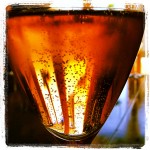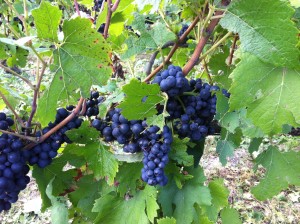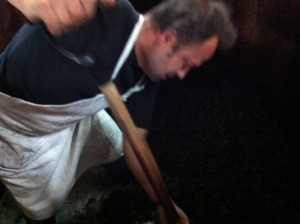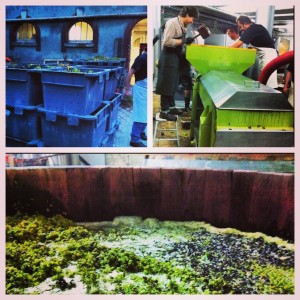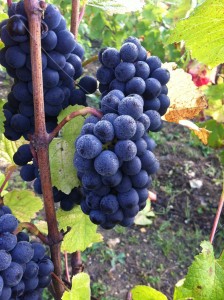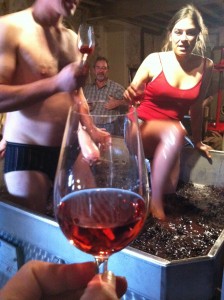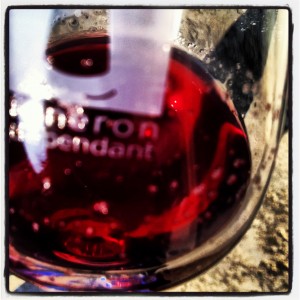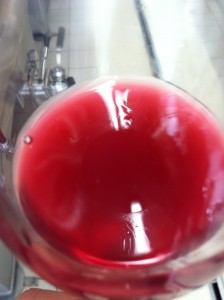However, everywhere else in the world still or sparkling rosé is made by allowing the juice to macerate on the skins for a period of time; in other words it is made much in the same way as red wine is made, with a shorter maceration period. Once the desired colour has been achieved the juice is ran off the skins and the resulting wine is called rosé de saignée.
Even if rosé d’assemblage is the norm here, there are a few Champenois producers who prefer to produce their rosé in the traditional way using the maceration method. This is not always an obvious choice as to make rosé de saignée one needs healthy ripe grapes, which means the grapes are often sorted again before they are destemmed and crushed. It is also more difficult to control the colour and tannin structure, which should not be too obvious if we want the wine to remain elegant after the second fermentation.
Jean-Baptiste Geoffroy is very much known for his innovative style of rosé de saignée. In fact he makes two different saignée champagnes, one is made from a 100% Pinot Noir, whilst the other one Blanc de Rose is made by co-fermenting Pinot Noir and Chardonnay. Geoffroy was the first person in Champagne to commercialize a co-fermented rosé de saignée and the wine is very sought after today.Jean-Baptiste called me the day he made his Blanc de Rose to ask me if I wanted to come and have a look. I jumped at the opportunity as the Blanc de Rose is one of my all time favourite rosé Champagnes, characterized by an amazing fragrance and elegance.
This year the grapes for the wine came from two vineyards in Hautvillers – the Chardonnay was picked in the morning on the steep slopes of the La Montagne vineyard, whilst the Pinot Noir was picked in the afternoon in the flatter La Grange area. Both the Chardonnay and Pinot Noir bunches were fully ripened, very flavoursome and rather small. I visited the La grange vineyard and was struck by the fact that in between the Pinot Noir plants there were many Chardonnay plants. Jean-Baptiste’s father – René Geoffroy – had replanted the vines that had died in the severe frosts of 1985 with Chardonnay. Because of this I think the percentage of Chardonnay in this years Blanc de Rose is slightly higher than normal. Jean-Baptiste uses large oak vats, which are closed off with a wooden lid during the 2 day maceration period. In order to better filter the wine (the vats have no filter) he makes a filter from bark twigs which he places in front of the exit trap, and a second filter is formed naturally by not destemming the first 10 cases of grapes in the vat. These grapes are once again placed in front of the trap, with a little help of the winemaker who jumps into the vat to manually do this. The next 40 cases are destemmed as well as crushed, and the last 10 cases are once again only crushed as the stems help to form a natural cap. After about 40 hours the rosé juice is ran off into tank where it is allowed to settle for 15-18 hours before the juice is pumped into barrel for the fermentation.All in all it took almost 6 hours to sort, destem and crush the grapes and to fill the two 17 hectolitre vats holding about 3 tonnes of grapes each. Jean-Baptiste and his cellar hand Gil Conejo sorted the grapes at the entrance of the destemmer. Two temporary cellar hands loaded the cases of grapes one by one into the destemmer, and a third cellar hand oversaw the even distribution of the grapes in the vat.
Organic icon Vincent Lavaloften works in a very traditional way to produce his expressive Champagnes. His rosé de saignée is characterized by its fine bubbles,tart red fruit flavours and its amazing freshness. This year the grapes to make the rosé came from a small steep south facing vineyard in Cumières called Les Chèvres. Les Chèvres is located about two thirds up the steep slopes carved out by the Marne between Cumières and Hautvillers. The sunny vineyard benefits from the cooling fog rolling off the river in the mornings and is exposed to the sun for most of the day. The low yields allowed the grapes to attain full ripeness before they were picked on this foggy autumn morning. Once all the grapes from the tiny vineyard had arrived in the winery the real party started!! No need to use a crusher destemmer when there are enough volunteers to gently crush the grapes with their feet!! In order to evenly and gently crush only 3 volunteers were allowed to enter the vat. The crates of grapes were added one by one with short pauses after five crates which allowed the volunteers to crush the grapes as they were added. The whole crushing operation took about 45 minutes and whilst the volunteers gently trotted through the vat, the other harvesters happily cheered them on whilst we all enjoyed a glass of Champagne Laval Rosé to bring good Karma to the rosé in the making!!Once the grapes are crushed enough they were allowed to macerate for about 24 hours before the juice is run off, allowed to settle and pumped into 228 liter barrels to undergo their alcoholic and malolactic fermentation.
At Vincent Charlot, a strong minded biodynamic producer with four hectares in Mardeuil I arrived just as he was pressing off his rosé de saignée one morning.
Vincent had started his #champagneharvest13 by selectively picking several parcels of old vine Meunier to make his rosé de saignée. Pickers were instructed to only pick fully ripe and healthy bunches – others were to stay on the vines a little longer as they will be picked later. Once the grapes arrived back at the winery they were sorted before they were destemmed and crushed. Charlot let the grapes macerate for about 36 hours before he pressed them off. The juice which was left to settle in a fiber glass tank for about 24 hours had the most gorgeous deep pink colour and tasted delicious – there were lots of floral notes, a little wild strawberry and sweet raspberry and a hint of spice in the back palate. After settling the juice will be pumped into old 228 liter barrels were it will slowly go through natural alcoholic and malolactic fermentation. I tasted a few more settled rosé de saignée juices in my travels around Champagne. Two which really stood out were the Pinot Noir from Jean-Sebastien Fleurie as well as the Pinot Noir from Benoit Lahaye. Both are biodynamic producers but as they are located in different parts of Champagne the juices were significantly different in flavour. Fleury’s rosé showed a lot of blue berries and almost violette notes whilst Lahaye’s was more about ripe red cherry’s, sweet strawberries and spice. Both juices were just about to start their fermentation so it will be interesting to see how the flavours develop after the alcoholic fermentation. Fleury’s wine will remain in stainless steel and was innoculated by an indigenous yeast strain from the Fleury vineyards whilst Lahaye works with a pieds de cuve and natural fermentation in barrel.
